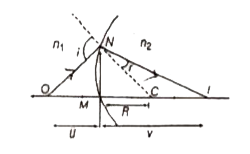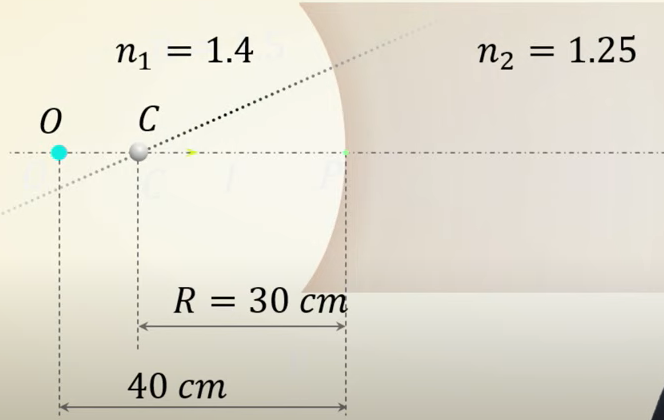A point object 'O' on the principal axis of a spherical surface of radius of curvature 'R' separating two media of refractive indices n1andn2 forms an image 'I' as shown in the figure below. Prove that n2v−n1v=n2−n1R

The correct Answer is:Correct derivation + correct derivation
Topper's Solved these Questions
Similar Questions
(a) Draw the ray diagram showing the geometry of formation of the image of a point object situated on the principal axis, and on the convex side, of a spherical of radius of curvature R . Taking the rays as incident from a medium of refractive index n1 to anothr of refractive index n2 show that n2v−n1u=n2−n1R where the symbols have their usual meaning.
(b) Use this relation to obtain the (thin) lens maker's formula.
View Solution(a) A point object is placed on the principal axis of a convex spherical surface of radius of curvature R, which separates the two media of refractive indices nx and n2(n2>n1)
Draw the ray diagram and deduce the relation between the object distance (w), image distance (v) and the radius of curvature (R) for refraction to take place at the convex spherical surface from rarer to denser medium.
(b) A converging lens has a focal length of 20 cm in air. It is made of a material of refractive index 1.6. If it is immersed in a liquid of refractive index 1.3, find its new focal length.
View SolutionFor the spherical interface shown in the figure, the two different media with refractive indices n1=1.4 and n2=1.25 are present as shown. The image will be formed at

View SolutionProve that n!r!=n(n−1)(n−2)...(r+1)
View SolutionProve that
(nr)+2(nr−1)+(nr−2)=(n+2r)
View SolutionProve that
(nr)+2(nr−1)+(nr−2)=(n+2r)
View SolutionTrace the rays of light showing the formation of an image due to a point object placed on the axis of a spherical surface separating the two media of refractive indices n1andn2. Establish the relation between the distance of the object, the image and the radius of curvature from the central point of the spherical surface.
Hence derive the expression of the lens maker's formula
View Solution(a) A point object, O is on the principle axis of a spherical surface having a radius of curvature, R. Draw a diagram to obtain the relation between the object and image distances, the refractive indicess of the media and the radius of curvature of the spherical surface.
View SolutionProceeding from Fermat'sprinciple derive the refraction formula for paraxial rays on a spherical boundary surface of radius R between media with refractive indices n and n'.
View SolutionProve that n(n−1)(n−2)...(n−r+1)=n!(n−r)!.
View Solution
